Cell Structure and Function in BIO 240. L4
1/141
There's no tags or description
Looks like no tags are added yet.
Name | Mastery | Learn | Test | Matching | Spaced |
|---|
No study sessions yet.
142 Terms
What is the function of the endomembrane system?
To modify, package, and transport lipids and proteins.
What are the two types of endoplasmic reticulum (ER)?
Rough endoplasmic reticulum (RER) and smooth endoplasmic reticulum (SER) that also stores Ca+
What is the role of the rough endoplasmic reticulum (RER)?
- studded with ribosomes, serves as the site of protein synthesis, and engages in protein modifications and phospholipid synthesis.
- ribosomes in the cytoplasm will move to the rough E.R and continue protein synthesis
- hydrophilic: proteins secreted
- hydrophobic: remains in the rough ER
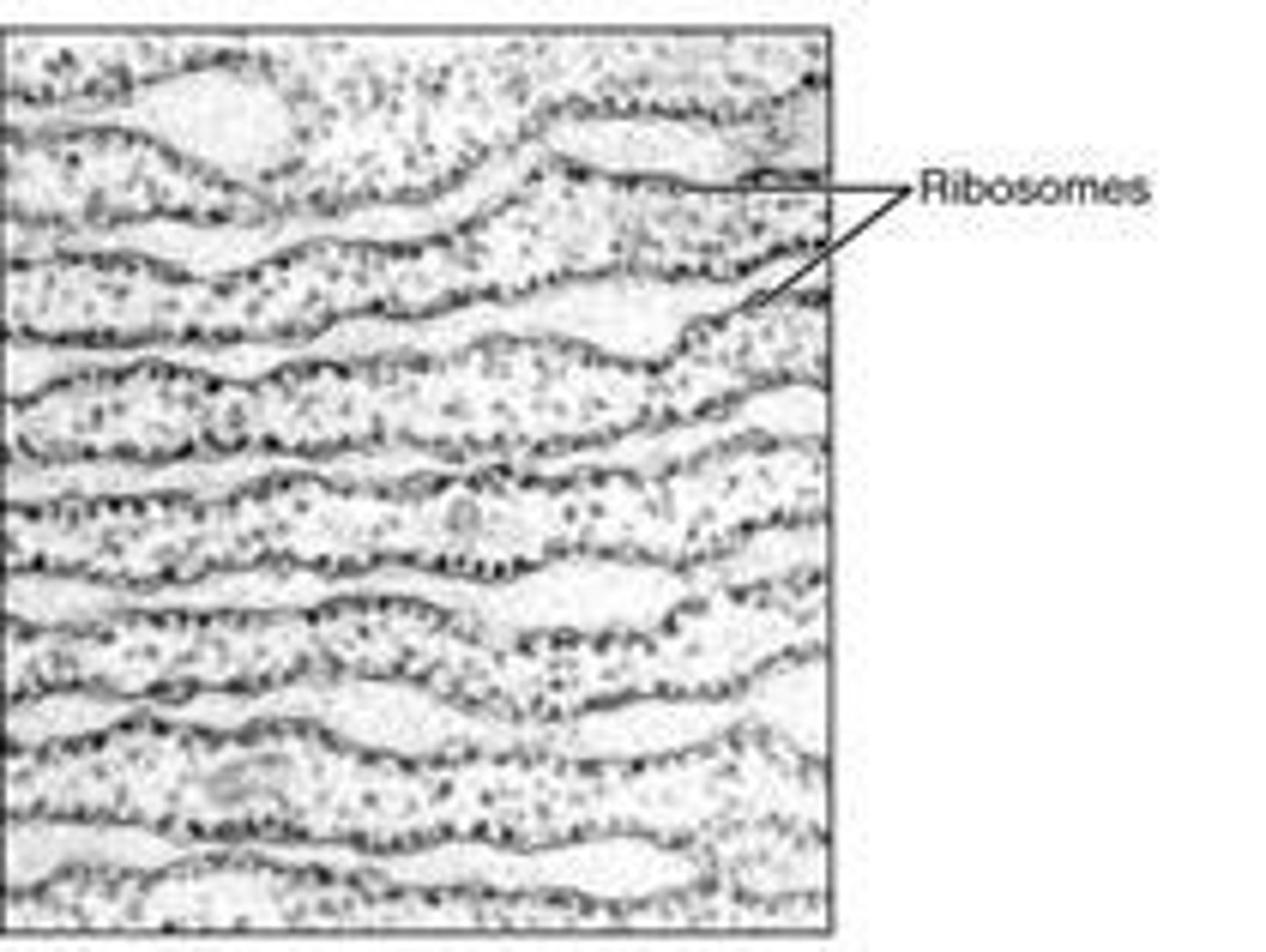
what are the organs associated with the RER
pancreas, liver, muscle, glands (hormones), and neurons (nerve function)
What does the smooth endoplasmic reticulum (SER) synthesize?
synthesizes phospholipids and steroid hormones, regulates calcium concentration, metabolizes carbohydrates, and breaks down toxins.
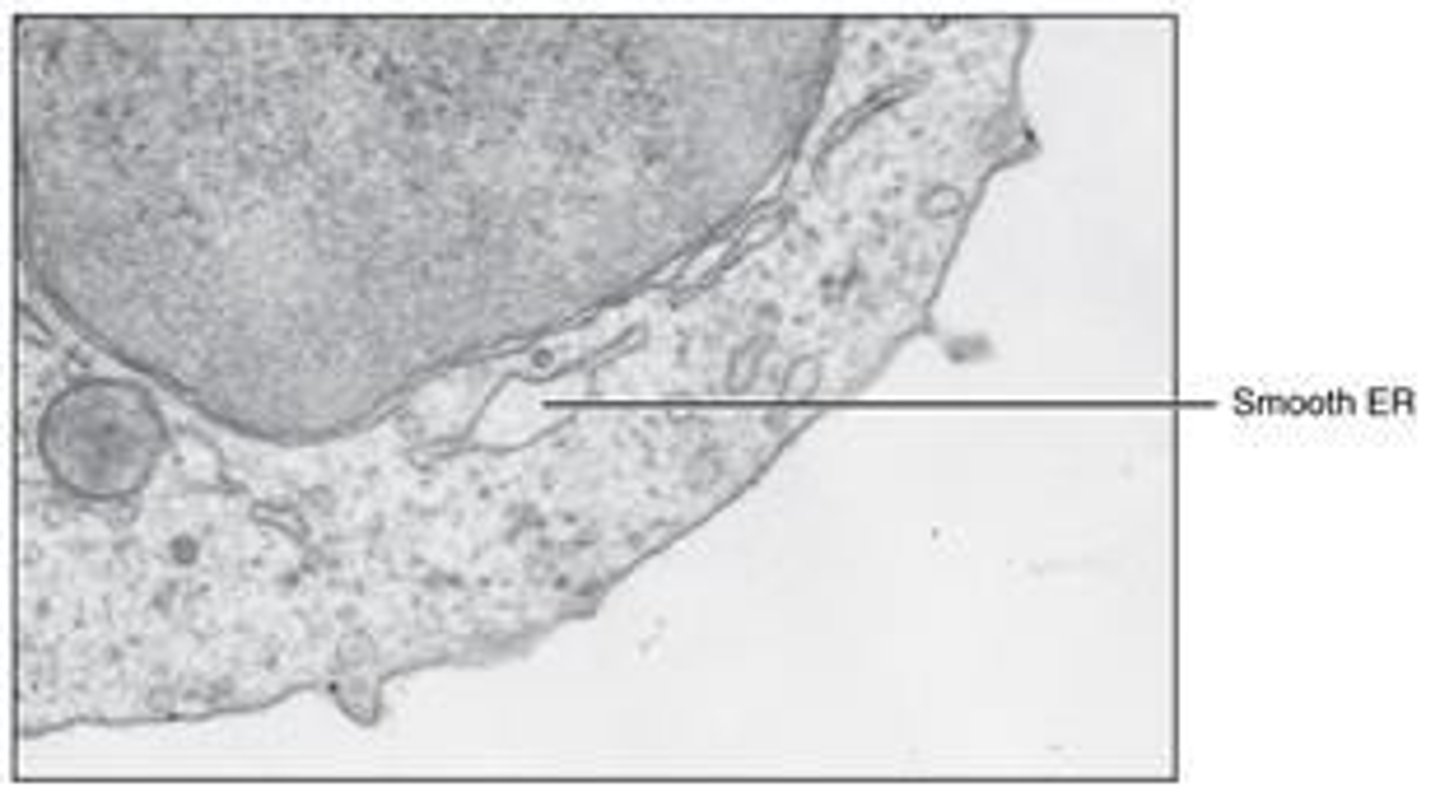
what are the organs associated with SER
liver and muscle
what do proteins have?
signal sequences that tell them where to go
What is the primary function of the Golgi apparatus?
- organizes, modifies, and packages neurotransmitters, hormones, and other secreted proteins of the ER.
- produces lysosomes filled with digestive enzymes
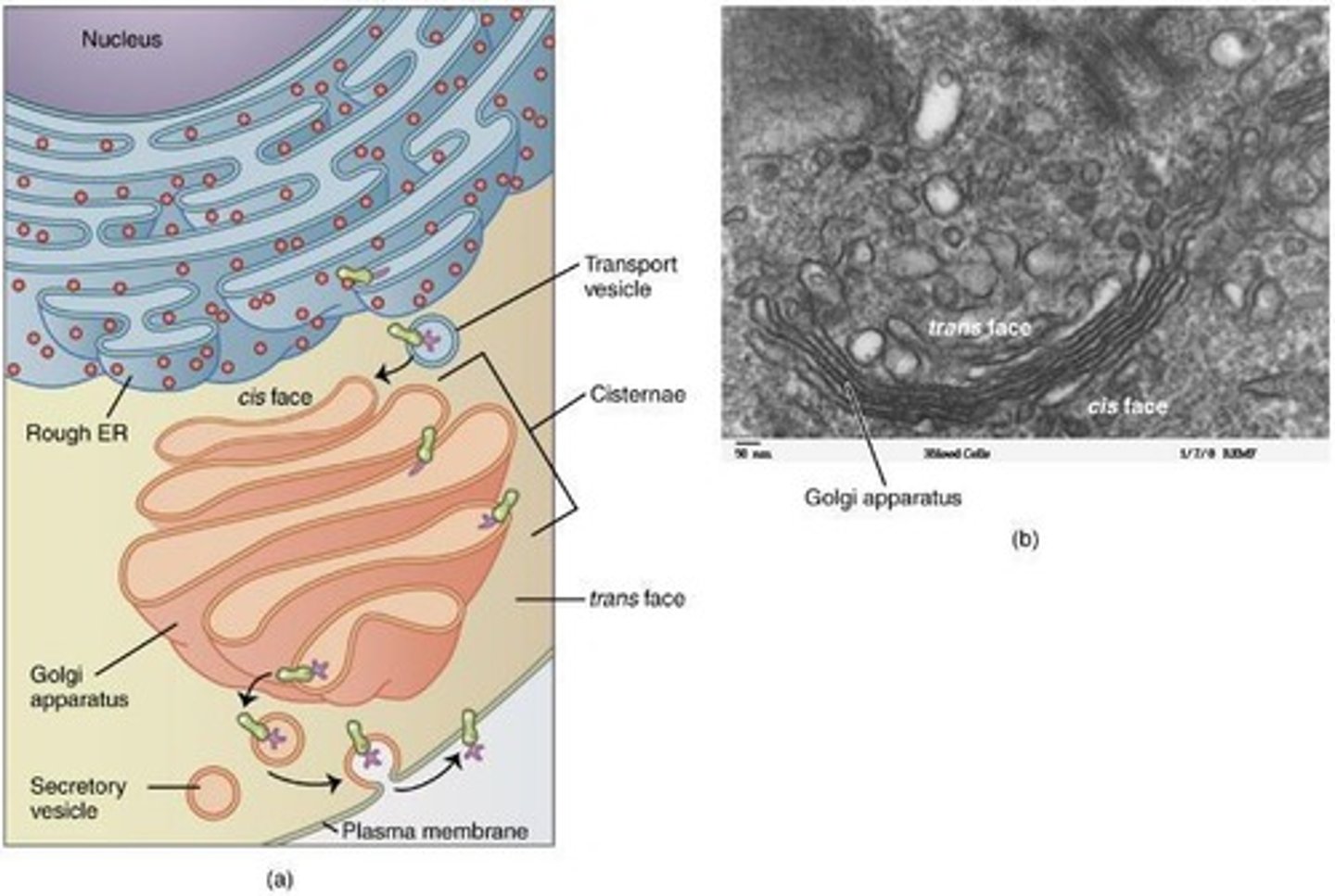
What are the two faces of the Golgi apparatus and their functions?
- Cis-face receives 'unfinished' proteins in vesicles from RER
- trans-face delivers 'finished' proteins in vesicles that budd off the plasma membrane
what are the organs associated with the golgi apparatus
pancreas (insulin and glycogen) are hormones that are secreted
What are vesicles and their role in cellular transport?
- Membrane-bound sacs that function in storage and transport, allowing exchange of membrane components.
- transport vesicles comes from the ER to carry proteins and lipids to the golgi where its modified to the cell membrane
What are the key features of mitochondria?
Bounded by exterior (similar to plasma membrane) and interior membranes, contains its own DNA (from your mother), partitioned by cristae, and functions in ATP synthesis.
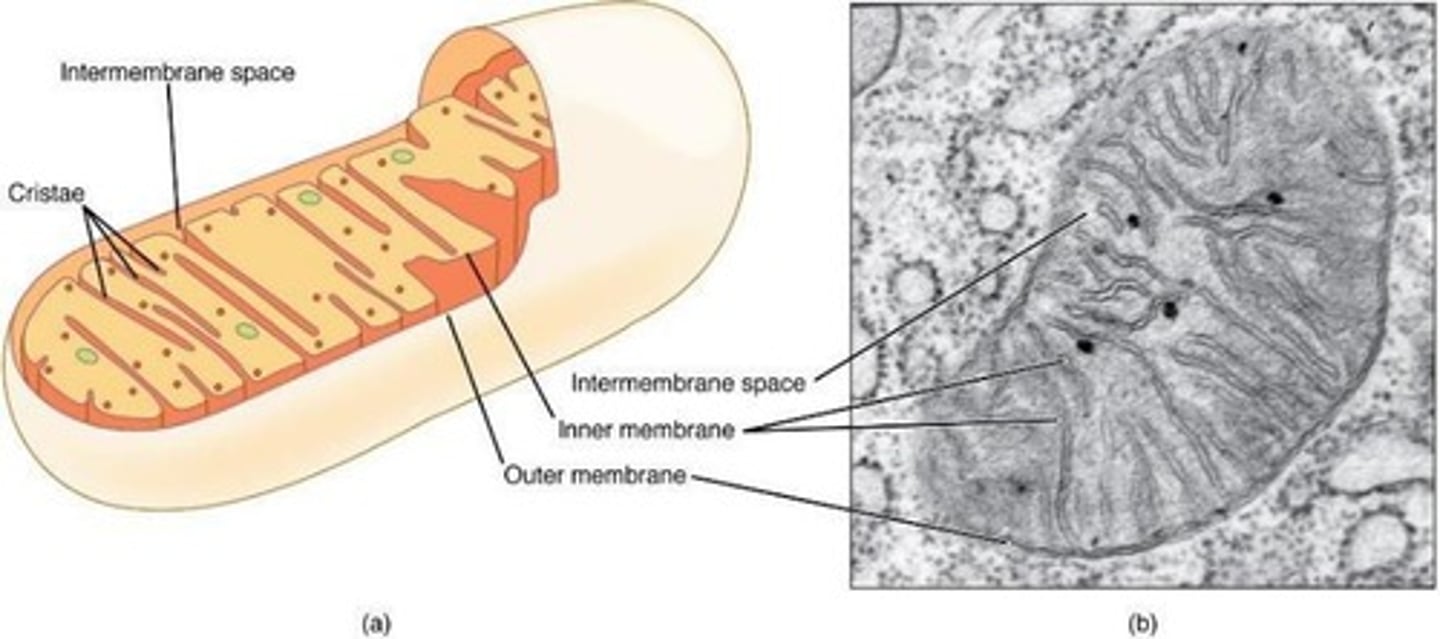
mitochondria uses what to make ATP?
glucose
what is the organ associated with the mitochondria?
muscle (needs energy to contract) and heart
The more mitochondria cells have, the more?
energy cells have
What macromolecule do mitochondria use first to make ATP?
Carbohydrates (glucose).
What is the function of peroxisomes?
To detoxify harmful substances and metabolize lipids using various enzymes.
What toxic molecule do peroxisomes produce and how is it broken down?
They produce hydrogen peroxide (H2O2), which is broken down by catalase into non-toxic oxygen and water.
are peroxisomes part of the endomembrane system?
no
what is the organ associated with peroxisome?
liver and kidney
What is the function of lysosomes?
To break down macromolecules into their constituent parts for recycling such as proteins into amino acids and polysacc to monosacc
- broken by hydrolysis
What type of enzymes do lysosomes contain?
Hydrolases that digest proteins, nucleic acids, lipids, and complex sugars.
What is the pH level inside lysosomes compared to the cytoplasm?
The pH within lysosomes is more acidic than that of the cytoplasm. its lower than 5 as the cytoplasm is higher than 5.
what is autophagi?
when were starving the cells can digests its own component. similar to how lysosomes can digest and release its content inside and outside of the cell.
what are the organs associated with lysosomes?
white blood cells and liver
- catabolic and anabolic reactions
What are the three components of the cytoskeleton?
Microtubules, microfilaments, and intermediate filaments.
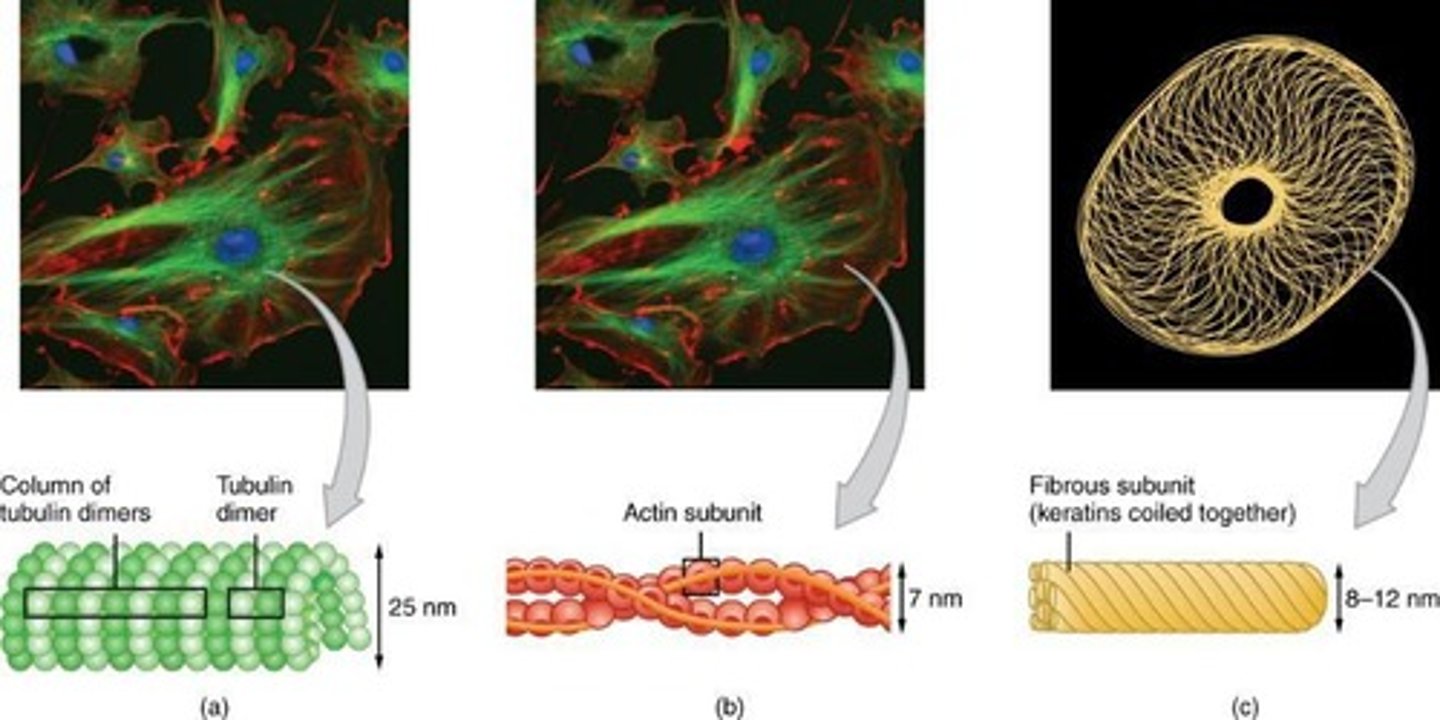
What is the role of the cytoskeleton in the cell?
To maintain cell shape and structure, promote cellular movement, and aid in cell division.
What are microfilaments and their function?
- Actin filaments that facilitate cell movement, such as muscle cell contraction.
- skeletal muscle, heart, and smooth muscle
- most thin (7nm)
What are microtubules and their significance?
They are involved in the structure of centrioles and eukaryotic flagella (locomotion) and cilia, cell division, has transport vesicles for movement, centrioles are called "microtubule organizing centers". It is the thickest (25nm)
What are intermediate filaments and their function?
- thickness is between (8-12nm)
- has diverse proteins such as keratin in our hair, neurofilaments, and lamins (filaments)
- helps organelles stay in place
- cellular movement of organelles and gives strength to tissues
Microfilaments thicken..
the cortex around the cell's inner edge. Like rubber bands, they resist tension.
what maintains a cells shape by resisting compressive forces?
microtubules in the cell's interior
what holds organelles in place throughout the cell?
intermediate filaments
What are centrioles also known as?
Microtubule organizing centers.
What is the main function of the Golgi apparatus regarding hormones and neurotransmitters?
To package them for secretion.
What is the significance of the rough ER being studded with ribosomes?
It indicates its role in protein synthesis.
How does the smooth ER contribute to cellular calcium regulation?
By regulating the concentration of calcium ions (Ca2+) within the cell.
What structures make up the cytoskeleton?
Flagella, cilia, microfilaments, microtubules, and intermediate filaments.
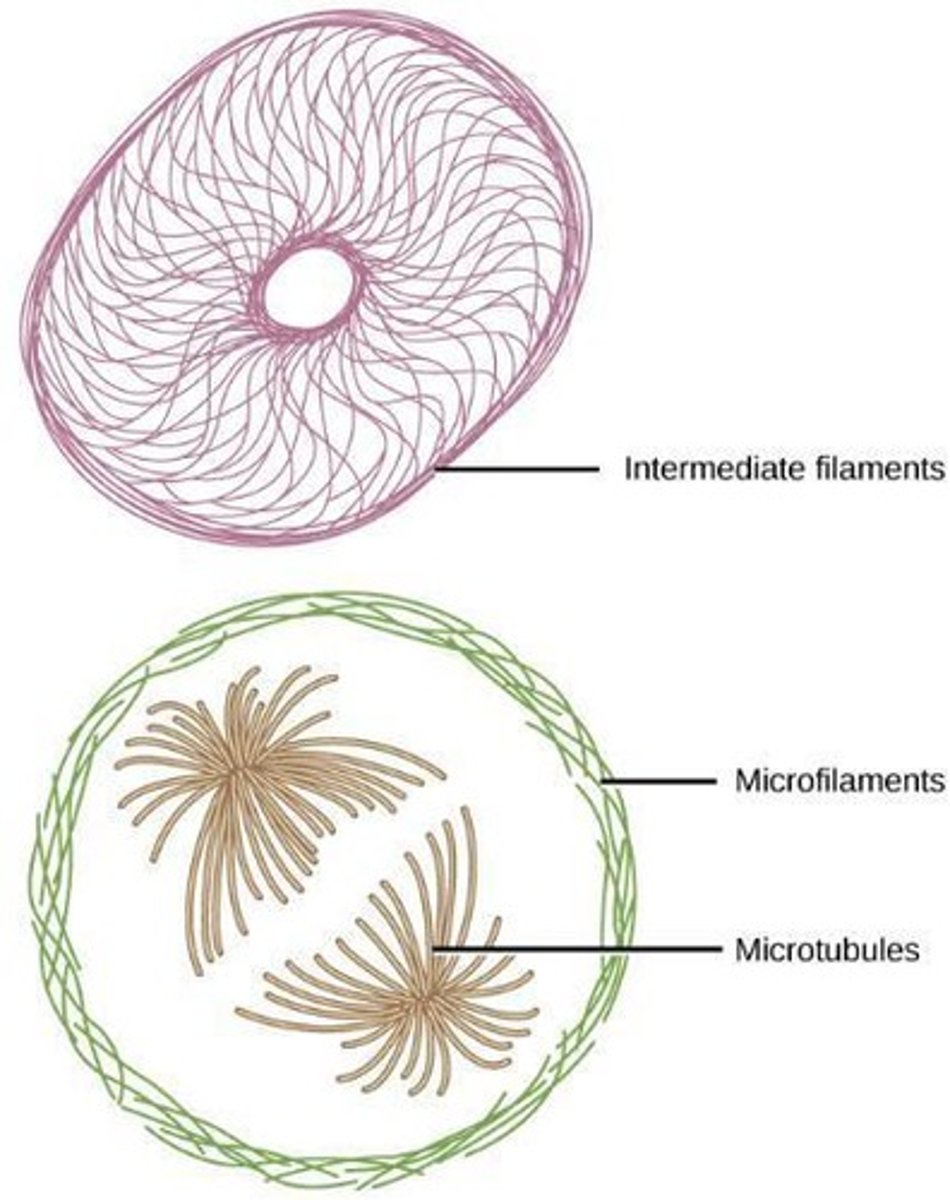
What is the primary function of the cytoskeleton?
To provide cellular support, strength to tissues, and facilitate cellular movement of organelles.
How do microfilaments contribute to cell structure?
They thicken the cortex around the cell's inner edge and resist tension like rubber bands.
What role do microtubules play in the cell?
They maintain the cell's shape by resisting compressive forces.
What is the function of intermediate filaments in a cell?
They hold organelles in place throughout the cell.
What is the nucleus's role in the cell?
It serves as the control center of the cell.
What are the components of the nuclear envelope?
Two phospholipid bilayers with with a nuclear envelope with nuclear pores that allow molecule exchange.
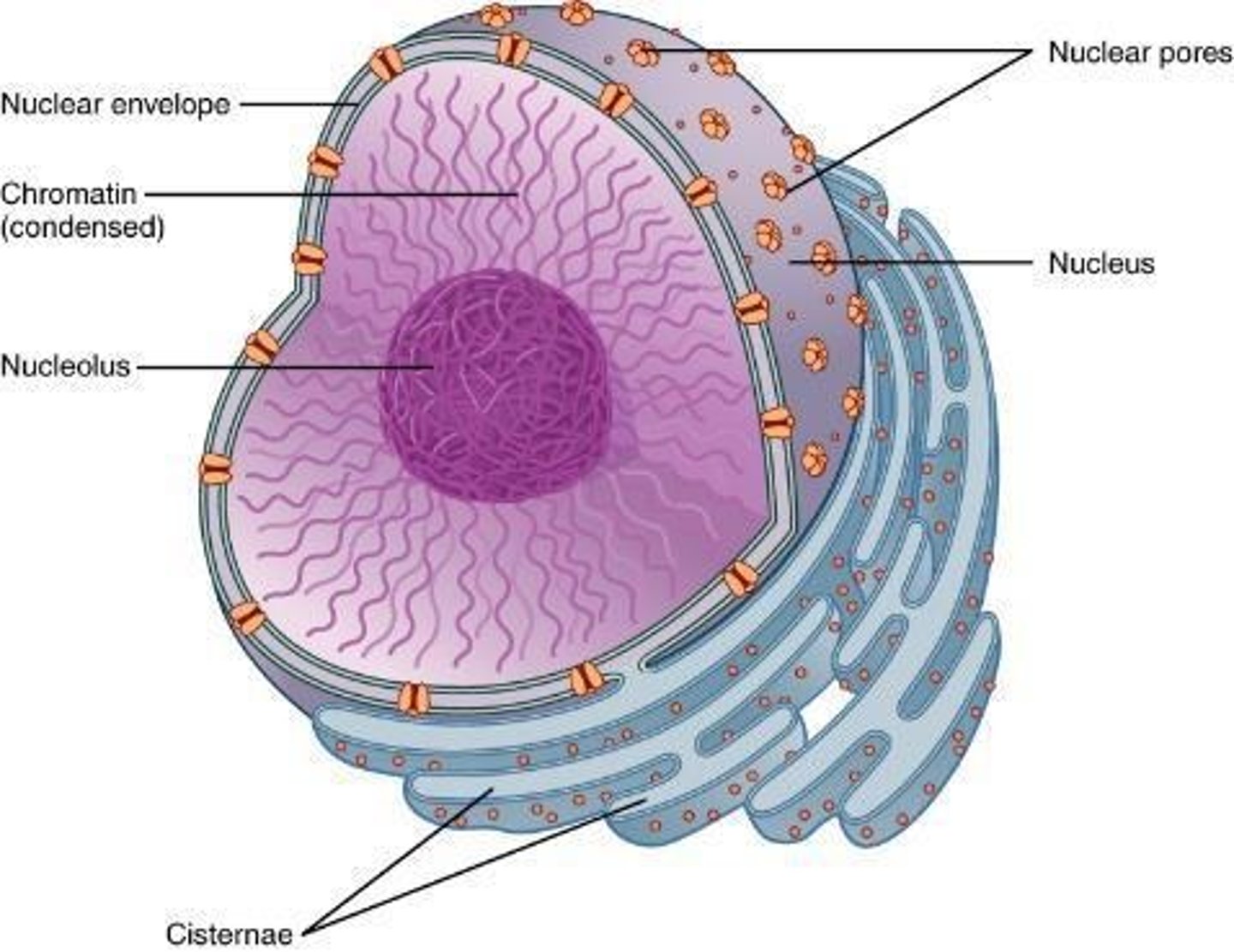
What substances are contained within the nucleus?
Nucleoplasm (fluid material), DNA, nucleolus (site of protein synthesis and pre-packaging of ribosomes), and proteins called histones where DNA is wrapped
What distinguishes multinucleate muscle cells from other muscle cells?
Multinucleate muscle cells, like skeletal muscle cells, contain many nuclei, unlike cardiac and smooth muscle cells which have a single nucleus.
muscle fibers are?
long and fibrous
How do mature red blood cells differ from erythroblasts?
Mature red blood cells lack a nucleus while erythroblasts extrude their nucleus to make room for hemoglobin.
What is the structure of DNA?
DNA is a double helix composed of two complementary strands bonded by nitrogenous base pairs.
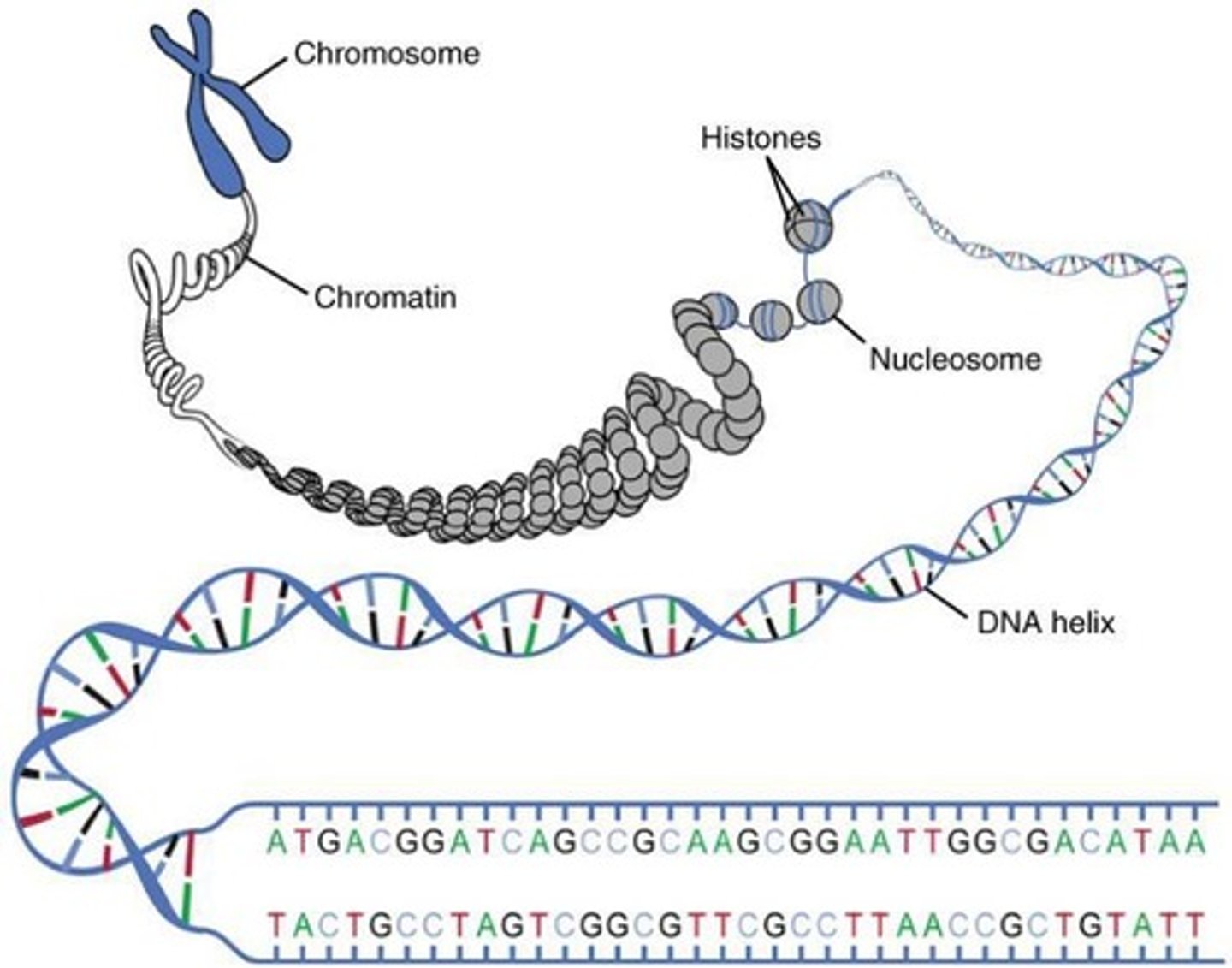
What are the two primary roles of DNA?
To replicate itself and to direct the synthesis of all cellular activities.
what are chromatins?
unfolded to be copied where DNA wrapped around proteins (histones)
what is folded during cell division?
chromosomes
what are the two roles of DNA?
- Makes copies of itself with replication of RNA
- direct the synthesis of all the activities of the cell (transcription)
What are the phases of the cell life cycle?
- Interphase (G1: growth S: dna replication, G2: growth),
- Mitosis (cell division) (Prophase, Metaphase, Anaphase, Telophase), and Cytokinesis.
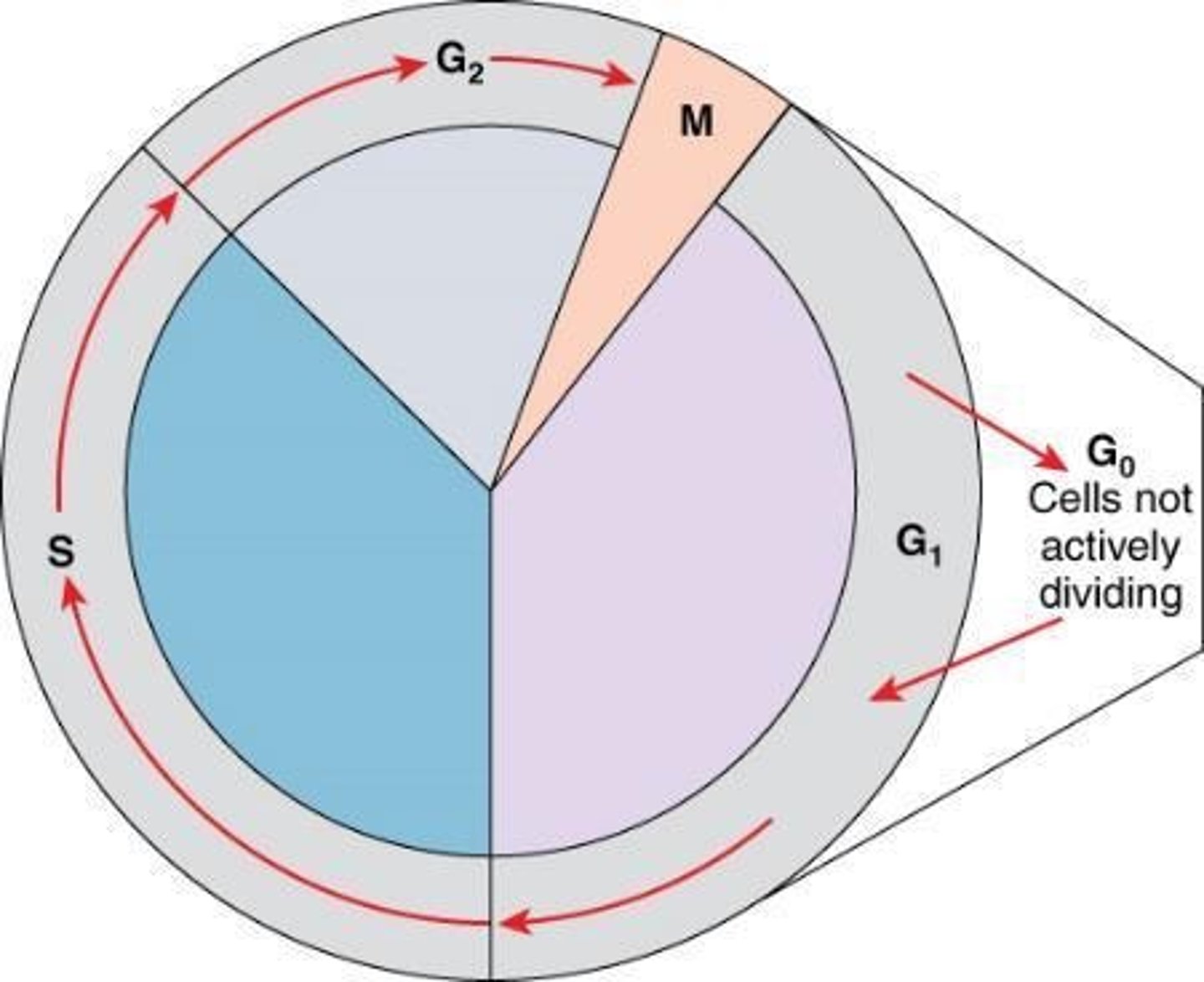
what happens in interphase?
DNA replicates
what happens in G1 phase?
growth where most cells remain in this stage most of the time
what happens in S: DNA replication?
synthesis where DNA is replicated
what happens in growth G2
the cell is making sure the DNA is replicated so the whole 46 chromosome is produced and replicated. It makes sure the cell is ready for division as it synthesizes protein
what is in mitosis (cell division)
Prophase
Metaphase
Anaphase
Telophase
what is the purpose of mitosis?
To create two identical daughter cells with the same number of chromosomes as the parent cell. its an asexual reproduction
what happens in prophase?
Chromosomes condenses into chromosomes, nuclear envelope breaks down, spindle fibers emerge from centromeres, centromeres move toward opposite poles
what happens in prometaphase
The nuclear envelope fully breaks down
Spindle fibers extend and begin attaching to kinetochores (special structures at centromeres)
Chromosomes start to move toward the cell's center (but are not yet aligned)
what happens in metaphase?
Chromosomes line up in the middle (equator) of the cell and
Spindle fibers attach to centromeres
what happens in anaphase?
Sister chromatids split and move to either pole
what happens in telophase?
the two daughter cells separate. the chromosomes begin to unwind and a nuclear envelope forms around each set of chromosomes
what happens in cytokinesis or G0:
not actively dividing like neurons, skeletal muscle fibers
What is the function of the cytokinesis?
The division of the cytoplasm and completes cell division by forming two separate daughter cells
what happens in cytokinesis in animal cells
a cleavage furrow forms and separates the daughter cells
what happens in cytokinesis in plant cells
The cell plate divides the cytoplasm and forms a cell wall and separates the daughter cells
What happens during the S phase of the cell cycle?
DNA replication occurs, duplicating chromosomes.
How many chromosomes do human diploid (2N) cells have?
46 chromosomes.
describe the components of DNA
- double stranded helix bonded by hydrogen bonding
- produce a copy of each strand
- complementary strand that is synthesized from original strand that is composed of two complementary strand
- a nitrogenous base and a phosphate group. 5'-->3' where 5 is the phosphate group and 3 is hydroxyl. its antiparallel
genes encode?
genetic information about the complete organism
How does the genetic
information get out of the
nucleus?
Genetic information is copied from DNA into messenger RNA (mRNA) during transcription. The mRNA then exits the nucleus through nuclear pores and travels to the cytoplasm, where it directs protein synthesis at ribosomes.
HOW MANY CHROMOSOMES DO HUMAN DIPLOID (2N) CELLS HAVE?
46- 23 from each parent
What enzyme unzips the DNA double helix and separates strands?
Helicase
What is the role of DNA polymerase?
Synthesizes the new complementary DNA strand by adding nucleotides to the primer.
what is a leading strand
- Made continuously in one smooth piece.
- Synthesized in the same direction as the DNA is being unzipped (toward the replication fork).
what is a lagging strand
- Synthesized in the opposite direction of the fork movement
- Because the template runs 5′ → 3′, and DNA polymerase can only build 5′ → 3′, it must synthesize the new strand in short, backward segments, away from the fork.
What is the molecular structure of RNA?
RNA is typically single-stranded and made of ribonucleotides linked by phosphodiester bonds.
What are the four major types of RNA?
Messenger RNA (mRNA), ribosomal RNA (rRNA), transfer RNA (tRNA), and microRNA (miRNA).
Which types of RNA are directly involved in protein synthesis?
Messenger RNA (mRNA), ribosomal RNA (rRNA), and transfer RNA (tRNA).
What is the significance of base pairs in DNA?
Base pairs are set as A-T and G-C, forming the rungs of the DNA double helix.
Describe mRNA?
a base-paired copy of
DNA (transcription) that
takes the
'message' to the ribosomes
describe rRNA
- rRNA and proteins make up
ribosomes
- Ribosomes are the site of
protein synthesis
- Large ribosomal subunit
- Small ribosomal subuni
describe tRNA
Takes amino acid to ribosomes
transcription within the cell nucleus produces an?
mRNA that is modified and sent to the cytoplasm for translation
how is transcription decoded into a protein?
with the help of a ribosome and tRNA molecules.
transcription is from?
DNA to mRNA where a gene on the DNA molecule is transcribed into a complementary mRNA molecule.
translation is involved in?
protein synthesis
in regulation of gene expression, ever cell in your body has the same DNA however?
not every gene is turned on in every cell
Gene expression is regulated by proteins called
Transcription Factors: that control whether RNA polymerase can bind to a gene's promoter and start transcription.
They act like on/off switches or dimmers for gene expression.
Some promote gene expression; others block it.
in microRNA how many rna molecules are there?
22 nucleotides that help regulate gene expression after transcription. These molecules bind to mRNA molecules and Block translation and trigger mRNA destruction
What is chromatin and its role in DNA?
Chromatin is DNA that is unfolded to be copied, while chromosomes are folded DNA during cell division.
What is the significance of histones in DNA structure?
Histones are proteins that DNA wraps around to form chromatin.
What is the role of messenger RNA (mRNA) in protein synthesis?
mRNA is a base-paired copy of DNA that carries the genetic message to the ribosomes for protein synthesis.
What are the components that make up ribosomes?
Ribosomes are made up of ribosomal RNA (rRNA) and proteins.
What is the function of transfer RNA (tRNA)?
tRNA transports amino acids to the ribosomes during protein synthesis.
What occurs during transcription?
During transcription, a gene on the DNA molecule is transcribed into a complementary mRNA molecule.
What are transcription factors?
Transcription factors are proteins that influence the binding of RNA polymerase to specific genes on the DNA.